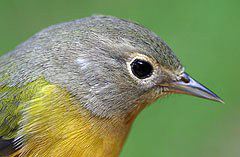|
|
|||
|
THIS WEEK at HILTON POND |
|
ANOTHER WESTERN VAGRANT We've been observing and banding Ruby-throated Hummingbirds since 1984 at Hilton Pond Center, and as of this week we've captured 2,662 of them in special traps and nets scattered around the property. From mid-March to mid-October we keep a sharp eye out for these tiny birds, pulling the string on new ruby-throats that enter traps outside the old farmhouse windows.  We also collaborate with other banders interested in "vagrant hummingbirds"--species from Mexico and the western U.S. that are being seen with increasing regularity east of the Mississippi after "our" ruby-throats fly to Central America for the winter. Thanks to the web sites for Hilton Pond Center and Operation RubyThroat: The Hummingbird Project, we get numerous e-mails and phone calls from folks who have spied an unusual hummingbird or one that is "out of season." If the sighting is near the Center, we usually try to investigate it ourselves; otherwise we forward the information to another bander who may be closer. Driving Carolina highways and byways in pursuit of vagrant hummers is rewarding, of course, and it does provide insights about hummingbird migration and dispersal, but it uses up lots of time. Thus, we were grateful in November 2001 when a female Rufous Hummingbird finally came to US at Hilton Pond Center. We continue to maintain several traps containing hummingbird feeders throughout the year, so it was simply a matter of watching that bird until she entered a trap normally used to capture Ruby-throated Hummingbirds. This week, while ruby-throats were still here--albeit in dwindling numbers--we were visited by another western vagrant hummingbird, this time a young male Rufous. 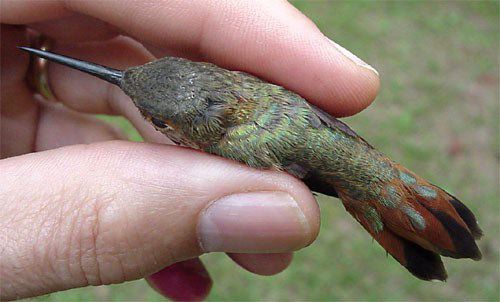 On 23 September 2002, as we were sitting at our computer hammering away at a PowerPoint presentation, what to our wondering ears did appear but an unusual buzzing sound. It was coming from the baby monitor receiver that sits on our desk from March through October. The transmitter end of the device perches atop a pull-string hummingbird trap on the deck outside the kitchen window of the old farmhouse and picks up and relays the sounds of nature that make our computer work a lot more pleasant.
Nearly all the vagrant Rufous hummers we have handled have been females, and most have been quite docile. This new bird at Hilton Pond was a spitfire and really did make chittering and buzzing noises quite unlike those produced by ruby-throats. We carefully removed him from the trap, brought him in to the lab table, and conducted the usual measurement and banding protocol, to wit: #Y14813; weight 3.06 g; wing chord 41.7mm; culmen (upper bill) 17mm; tail 27mm; throat with heavy dark streaking and nine metallic bronze-red gorget feathers. 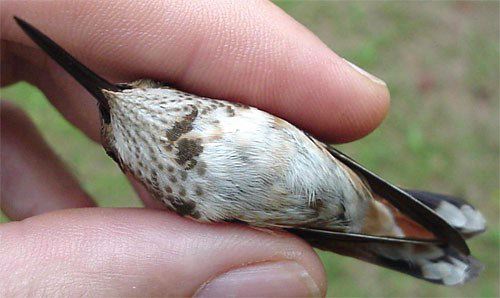 After banding, we inserted the Rufous hummer's bill into a feeder port and watched as he chugged down some sugar water as well-earned severance pay. Upon release he flew skyward and we wondered whether we'd ever see him again. We did, on the following day, when we retrapped him with ease. Since then we've observed this western hummer--which will breed nest year in Canada, southern Alaska, or the extreme northwestern contiguous U.S.--only one additional time, so we suspect he's moved on and will eventually return to those nesting grounds. There are several morals to this story. For one, be sure to keep at least one feeder up and freshly stocked with sugar water all through the winter and you may be visited by a vagrant hummingbird. For another, if you live east of the Rockies, please remember to report any sightings of hummers between 15 October and 15 March. (You can send an e-mail to RESEARCH and we'll forward your contact info if another bander is closer and can verify your bird.) In the meantime, we'll be listening closely to the back porch baby monitor as autumn progresses, all in the hope that another vagrant hummer will buzz in and try to tell us exactly what it thinks about being trapped, banded, and measured at Hilton Pond Center. 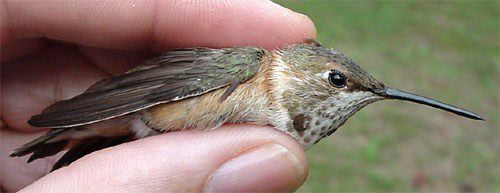 For more information about vagrant hummers, see Research: Winter Hummingbird Banding If you're interested in sharing your hummingbird observations and learning from other enthusiasts, you may wish to subscribe to Hummingbird Hobnob, our Yahoo!-based discussion group. Also be sure to visit our award-winning Web site for Operation RubyThroat: The Hummingbird Project; on it you'll find almost anything you want to know about hummingbirds, including more information about Hummingbird Banding.
If you enjoy "This Week at Hilton Pond," please help Support Hilton Pond Center for Piedmont Natural History. It's painless, and YOU can make a difference! You may wish to consult our Index of all nature topics covered since February 2000. |

 Over the past few winters, we've driven nearly 3,000 miles to check out reports, most of which have paid off with our being able to confirm a rare hummingbird visitor--such as the South Carolina state record Buff-bellied Hummingbird we banded last December near Lexington. The vast majority of winter vagrants in the Southeast are Rufous Hummingbirds, whose "normal" wintering grounds are in Central Mexico.
Over the past few winters, we've driven nearly 3,000 miles to check out reports, most of which have paid off with our being able to confirm a rare hummingbird visitor--such as the South Carolina state record Buff-bellied Hummingbird we banded last December near Lexington. The vast majority of winter vagrants in the Southeast are Rufous Hummingbirds, whose "normal" wintering grounds are in Central Mexico.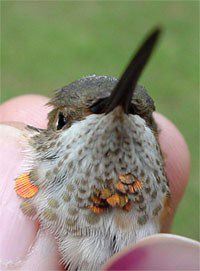 At the first hint of buzzing through the speaker, we leaped from our chair and ran to the kitchen to see a hummingbird hovering around the trap and trying to get at the feeder inside. Those of you who are attuned to unusual buzzing sounds will understand when we say we were not completely surprised to see that this hummer had extensive reddish color at the base of its tail feathers--a characteristic lacking in Ruby-throated Hummingbirds. The bird didn't enter the trap on the deck but made a beeline for one further away from the farmhouse, easily displacing an otherwise dominant ruby-throat that had been monopolizing the area all day long. New hummer enters trap, we pull string, and then we do mental cartwheels when the hummer glares at us through the wire and reveals a considerable number of bronze-red gorget feathers--cussing all the while in a language known only to hatch-year male Rufous Hummingbirds.
At the first hint of buzzing through the speaker, we leaped from our chair and ran to the kitchen to see a hummingbird hovering around the trap and trying to get at the feeder inside. Those of you who are attuned to unusual buzzing sounds will understand when we say we were not completely surprised to see that this hummer had extensive reddish color at the base of its tail feathers--a characteristic lacking in Ruby-throated Hummingbirds. The bird didn't enter the trap on the deck but made a beeline for one further away from the farmhouse, easily displacing an otherwise dominant ruby-throat that had been monopolizing the area all day long. New hummer enters trap, we pull string, and then we do mental cartwheels when the hummer glares at us through the wire and reveals a considerable number of bronze-red gorget feathers--cussing all the while in a language known only to hatch-year male Rufous Hummingbirds. Students at GLOBE-certified schools may submit winter hummingbird observations as part of Operation RubyThroat and GLOBE. Students can also correlate hummingbird observations with data on abiotic factors, including atmosphere, climate, hydrology, soils, land cover, and phenology. See the
Students at GLOBE-certified schools may submit winter hummingbird observations as part of Operation RubyThroat and GLOBE. Students can also correlate hummingbird observations with data on abiotic factors, including atmosphere, climate, hydrology, soils, land cover, and phenology. See the 